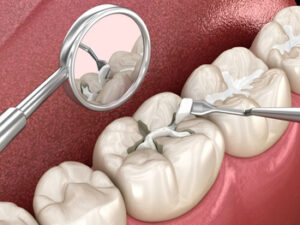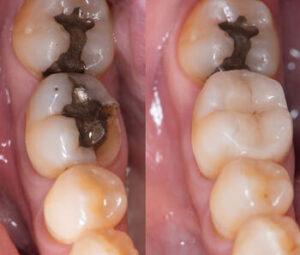When dealing with a damaged tooth, lost filling, or a dental emergency, a temporary tooth filling can provide a short-term solution to protect the affected area and prevent further damage. But what exactly is a temporary dental filling, how does it work, and what should you do to care for it properly? This detailed guide will cover all essential aspects of temporary fillings, including their purpose and how they differ from permanent tooth fillings.
What Is a Temporary Tooth Filling and Why Is It Used?
A temporary tooth filling is a short-term solution intended to protect a damaged tooth until a permanent filling, crown, or other treatment can be applied. Dentists often use temporary fillings in various situations, including:
- As an interim solution after a root canal procedure
- To protect a tooth with a deep cavity before a permanent filling is placed
- When a temporary crown is needed before a permanent crown is ready
- In cases of a lost filling, where the patient cannot immediately receive a replacement
- During a dental emergency, such as a cracked or damaged tooth that requires further assessment
Temporary dental fillings are designed to last for a few weeks, ensuring that the affected tooth remains protected while waiting for a more permanent solution.
What Materials Are Used in Temporary Fillings?

- Zinc Oxide Eugenol: A soothing material with pain-relieving properties, often used in temporary fillings.
- Cavit: A soft, self-hardening material that provides a temporary seal.
- Glass Ionomer Cement (GIC): Provides some level of fluoride release to help protect against further decay.
- Polycarboxylate Cement: A durable yet temporary solution that offers decent adhesion.
While these materials are designed to provide short-term protection, they are not as durable as permanent fillings and require proper care to prevent them from falling out prematurely.
How Long Does a Temporary Filling Last?
A temporary filling is not meant to last indefinitely. Most temporary dental fillings last for a few weeks, though the exact duration depends on the type of material used and how well the patient follows care instructions. If a temporary filling falls out too soon, it’s essential to visit the dentist to have it replaced, as an exposed cavity or damaged tooth can lead to further complications.
How to Care for a Temporary Filling
To ensure that a temporary filling remains intact until your next dental appointment, follow these care tips:
1. Avoid Chewing on the Affected Side
Since temporary fillings are not as durable as permanent ones, it’s advisable to avoid chewing hard or sticky foods on the affected side.
2. Brush Gently and Floss Carefully
Brushing is essential, but you should brush gently around the temporary filling to prevent dislodging it. When flossing, avoid pulling the floss up and down aggressively. Instead, slide it out gently to prevent pulling the filling out.
3. Avoid Certain Foods
Hard, sticky, and chewy foods can cause a temporary filling to loosen or fall out. Foods such as caramel, chewing gum, and crunchy snacks should be avoided.
4. Minimise Moisture Exposure
Excessive moisture can weaken some temporary fillings, particularly those made of materials like Cavit. Keeping the area dry while eating and brushing can help prolong the filling’s durability.
5. Follow Your Dentist’s Instructions
Every patient’s case is different, so always follow your dentist’s specific instructions on how to care for your temporary filling and when to return for a permanent filling or crown.
What Happens If a Temporary Filling Falls Out?
If your temporary filling falls out before your scheduled appointment for a permanent replacement, it’s important to contact your dentist as soon as possible. An unprotected cavity or exposed tooth can lead to increased sensitivity and pain, further decay, or a risk of infection.
If you cannot see your dentist immediately, keep the area clean by rinsing your mouth with warm salt water and avoid chewing on the affected side.
Temporary Fillings vs Permanent Fillings: What’s the Difference?
Temporary fillings serve as an interim solution, while permanent fillings are designed for long-term restoration. A temporary filling is meant for short-term protection, made of soft materials that are easy to remove, whereas a permanent filling is a durable, long-term solution that can last for years. While temporary fillings protect the tooth for a few weeks, permanent fillings are designed to withstand daily chewing and exposure to moisture.
While a temporary filling is only meant for short-term use, it plays a crucial role in protecting your tooth until a permanent filling, crown, or other treatment is applied.
When Should You Get a Temporary Filling Replaced?
A temporary filling should be replaced as soon as possible, ideally at the scheduled appointment with your dentist. However, if you experience any of the following, you may need an earlier replacement:
- The temporary filling becomes loose or falls out.
- You experience persistent pain or sensitivity.
- The filling starts to break apart or wear down.
- You notice a change in how your bite feels.
Delaying the replacement of a temporary filling can increase the risk of further decay, infection, and the need for more complex treatments like root canals or extractions.
Can You Use a Temporary Filling at Home?
In some cases, patients may use an over-the-counter temporary filling material to cover a cavity or lost filling until they can visit a dentist. These products, often referred to as dental repair kits, provide a temporary cap over the affected area. However, they are not a substitute for professional dental care and should only be used as a short-term measure.
Final Thoughts: Why a Temporary Filling Matters

If you have a temporary filling, following your dentist’s instructions carefully and scheduling your next appointment for a permanent solution is crucial. Temporary fillings are meant to bridge the gap between treatments, so don’t wait too long to replace them with a more durable, long-lasting dental filling or crown.
For professional dental care and expert advice on temporary and permanent fillings, schedule an appointment with Dental 266 today at 02 9051 0600.
Note: Any surgical or invasive procedure carries risks. Before proceeding, you should seek a second opinion from an appropriately qualified health practitioner.
References
- News-Medical. (n.d.). The advantages of using glass ionomers in dentistry. News-Medical Life Sciences. Retrieved from https://www.news-medical.net/whitepaper/20180710/The-Advantages-of-Using-Glass-Ionomers-in-Dentistry.aspx
- Cleveland Clinic. (n.d.). Dental fillings. Cleveland Clinic. Retrieved from https://my.clevelandclinic.org/health/treatments/17002-dental-fillings
- Healthline. (n.d.). Temporary filling: Care, types, and what to expect. Healthline. Retrieved from https://www.healthline.com/health/temporary-filling






